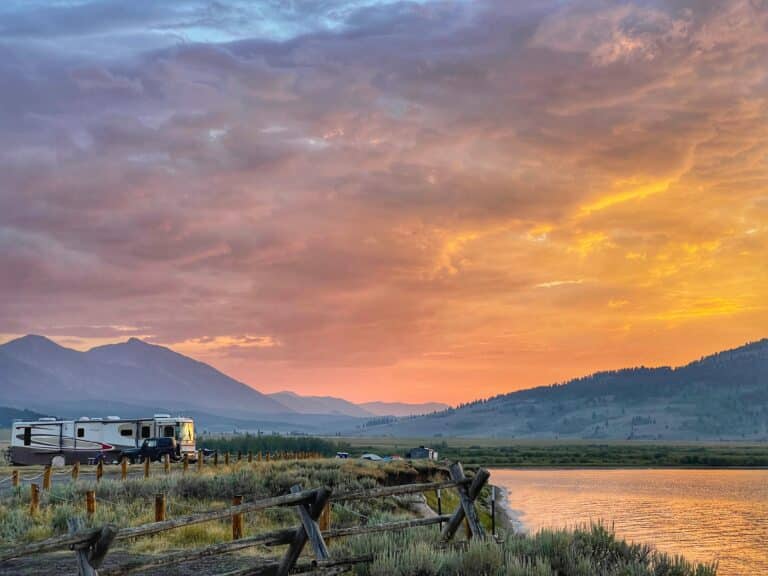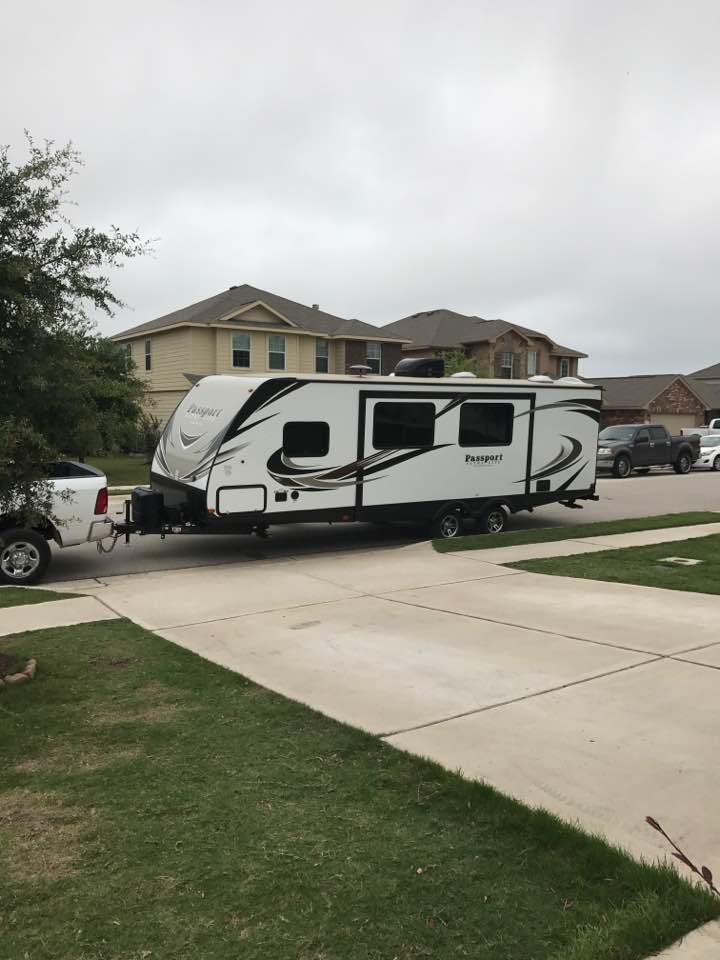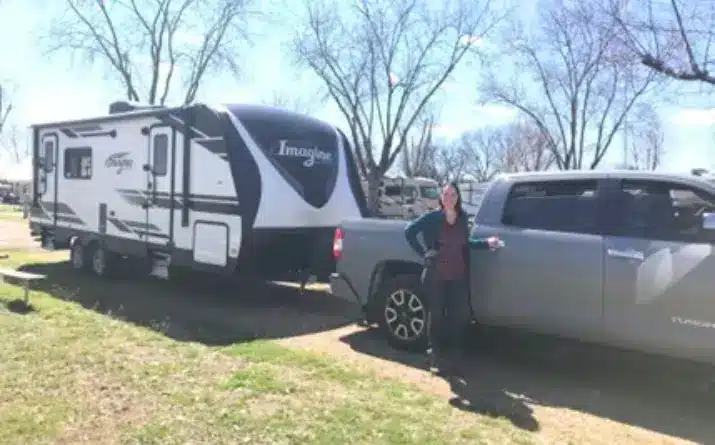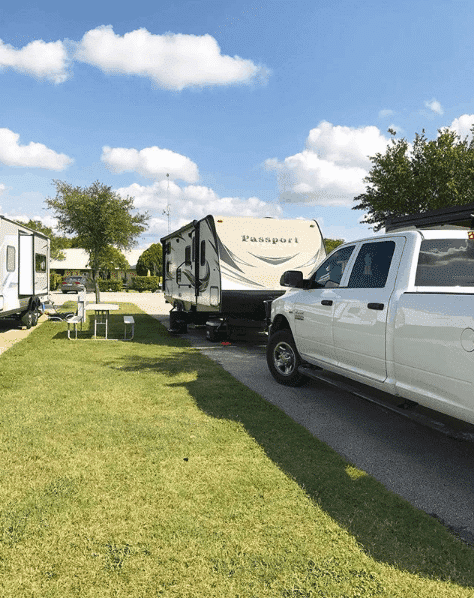Your Ultimate Guide to RV Living: All The Steps We Took To Prepare
Are you in the research phase for all the ins and outs of RV living? We’ve been there and done that. We moved from a house to full-time RV living in 100 days. So, trust me when I say we completely understand the stress levels when preparing to live in an RV full-timethe initial phase of part is.

You have a bazillion questions, right?
Those bazillion questions are keeping you up at night, right?
You’re thinking about decluttering.
You’re thinking about selling your house.
You’re thinking about purchasing that home on wheels.
You’re thinking about tow vehicles, how much it costs to live in an RV, if RV parks are safe, what your friends and family will think…and the list goes on and on and on.
Guess what? We’re here to help.
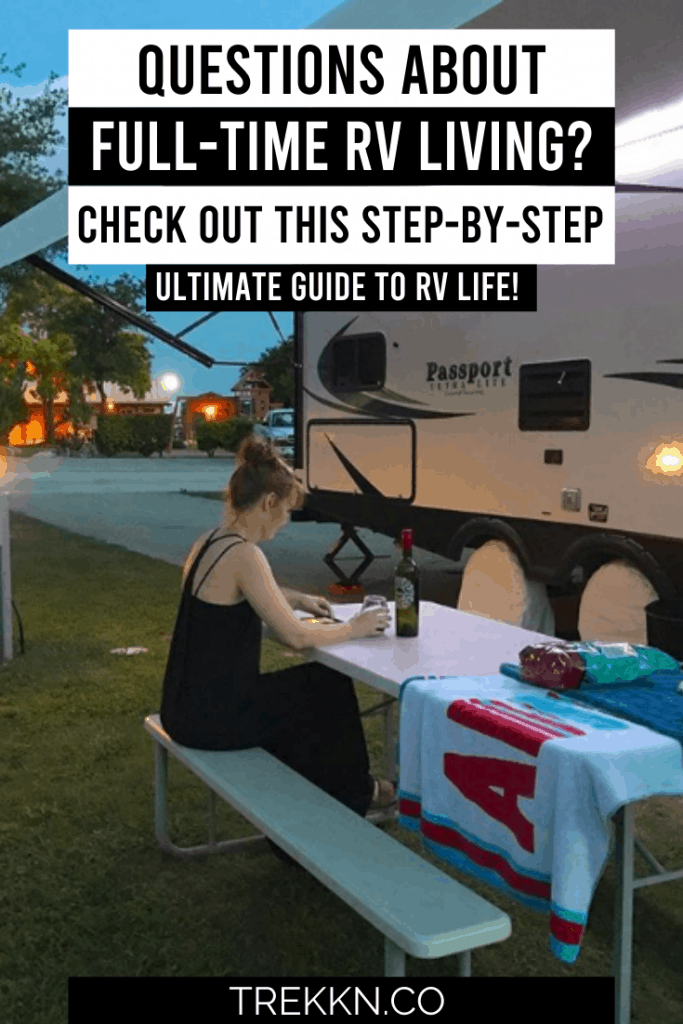
Your Ultimate Guide to RV Living
When you’re thinking about and planning towards full-time RV living, there are a lot of pieces to put into place. And all of those pieces can be completely and utterly overwhelming.
When we first started the process, we made a list. This list consisted of all the things that needed to happen in order to actually move from our 2,200+ square foot house to our tiny home on wheels (around 200 square feet).
We also spent a ton of time checking out full-time RV blogs, watched an embarrassing number of RV videos and travel videos and basically ate, drank and slept the idea of this RV lifestyle.
At one point, we got so overwhelmed and so scared of the unknown that we almost quit. We were asking questions like is this lifestyle really worth all this headache and hassle, what if we go through all of this and we hate it, what if running a business on the road doesn’t work, plus fears, fears, and more fears.
Side note: You can read our blog post and watch our video covering our top five fears that almost kept us from living the full-time RV life here.
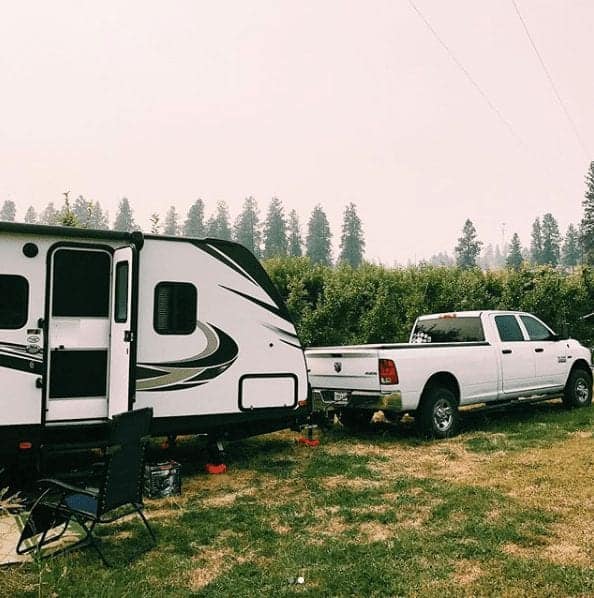
A Step-By-Step Guide to Full-Time RV Life
What we wished we had back then was a step-by-step guide to getting us from point A (the scared and confused almost-ready-to-quit point) to point B (the full-time RV life). We needed someone to hold our hand and tell us we’re pretty. Wait, just kidding.
We needed someone who had been through this process to share what they did to get themselves on the road and officially become full-time RVers.
Now we know everyone’s journey will be different. Some of you will already own your RV. Some of you won’t have a house to sell. Some of you are empty nesters and don’t have to worry about the kid factor in all of this. Some of you have been planning this for years and have slowly been getting your ducks in a row.
So all we can do is share our journey and hope that some of it helps answer your questions and relieves a bit of stress.
The Steps We Took to Make Full-Time RV Life Happen
Before we get into the nitty-gritty details, here’s a shortlist of the steps we took in order to make RV life happen:
- Step 1: Figuring Out Your Why
- Step 2: Conversations with Family
- Step 3: The Decluttering Process
- Step 4: Shopping For & Purchasing An RV
- Step 5: Getting the House Ready to Sell
- Step 6: Finances – Remote Income & Cutting Costs on the Road
- Step 7: Shopping For & Purchasing A Tow Vehicle
- Step 8: Buying ALL THE THINGS for That New Home on Wheels
- Step 9: Moving In
- Step 10: RVing Practice Run
- Step 11: Saying Goodbye and Officially Launching Into the RV Life!
Phew! That’s a lot of steps right? As I’m typing this up and reliving some of these decisions we had to make, I’m amazed that we actually made this happen because wow that was a stressful/difficult time.
But, it was so very worth it. The experiences we’ve had together as a family have brought us closer together and we’ll always have this special time in our lives to reminisce about for literally the rest of our lives.
Are you ready to dig in? Let’s do this.
Now, this is a very long and detailed guide explaining all the steps we took to make full-time RV living happen. So be sure to bookmark it, pin it or email it to yourself to save so you can reference it as you take steps toward living your full-time RV lifestyle dream.
How to Prepare for Full-Time RV Living
Step 1: Figuring Out Your Why

Travel has always been important part of our lives.
That was our why. We wanted to travel more, to show our kids the world and to do something a little different and challenging.
So, what is your why?
We believe figuring that out is a crucial first step to this process because that ‘why’ is what will keep you going through the difficult times.
We almost threw in the towel and decided not to full-time RV. It all became a little too much and our fears had a hold of us and wouldn’t let go.
So we had to go back to our why in order to make this happen.
Related Reading: One Family’s Move From A House to a Travel Trailer
Step 2: Conversations with Family
When we decided to put this idea in front of our kids, we had a daughter in college, a son that was about to graduate high school and a son in middle school. The logistics of all of this seemed a bit daunting.
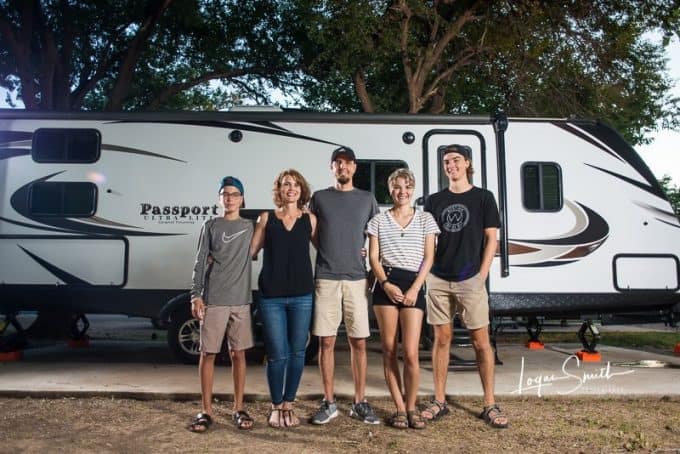
Image Credit: Logan Smith Photography
Our Daughter in College
We had questions about how our daughter would feel having us so far away at times after only being about 3 hours away from her for a year. We wondered how she would feel as she’s in class and we’re out hiking in the mountains or kayaking in the ocean. (Side note: this has been hard for her honestly.) We had questions about how this would all work when she’s on her summer, winter and spring breaks.
It did seem like kind of a logistical nightmare, but we’ve made it work.
How did we go about sharing this idea with her? We FaceTimed her and said something like ‘what do you think about the idea of us selling our house and moving into an RV for a year?’ And she said something like ‘um…what?!’ and then we talked through it some more and some more and yes, some more.
Long story short, she knew some of this would be difficult, but she was on board with it. And this journey has taken her to Canada (twice) and both the West and East coast. Although she’s with us only part of the time, she’s seen more than a lot of adults have in their entire lifetime.
Our Son Graduating High School
Throughout his senior year, our oldest son was struggling with what to do after high school. He just felt like immediately going to college (or even going at all) wasn’t the path for him. And what do the vast majority of kids and teachers and principals and adults only talk about as you’re nearing graduation? College.
He was asked questions like:
What colleges have you applied to?
What college are you going to?
What are you going to major in?
Aren’t you so excited about college?
To say his senior year was a bit hard and emotionally challenging, would be an understatement. And if you’ll let me jump on my soapbox for just a minute here…
Why don’t high schools encourage college alternatives and the kids who college isn’t right for? Let’s not forget about them. Let’s celebrate them too. Let’s make them feel like their decisions are just as valid and their lives have just as much value and potential as the college-bound.
Okay, I’m done.
Putting the idea to RV full-time in front of him wasn’t difficult and neither was him saying yes. Photography is one of his passions and he’s been able to fully embrace it and hone his skills.
Our Son in Middle School
This conversation was an easy one. We could have said to our middle schooler something like ‘Hey, so we’re thinking about moving to XYZ country and living in a tent while living off the land and learning all the ways of the indigenous people‘ and he would have said ‘Cool!‘
So asking him what he thought about selling our house and most of our possessions and moving into an RV to travel the U.S. and Canada full-time was the best run on sentence he’s ever heard leave our lips. 🙂
He loved the idea of non-traditional schooling and as one of his birthday presents, we actually pulled him from school and started homeschool in February, even though we weren’t leaving until May.
Part of his schooling ended up being everything it took for us to hit the road. From RV and truck shopping to pulling the travel trailer for the first time to route planning, this was hands-on learning at its best.
Related Reading: Full-Time RV Living with a Teenager
Step 3: The Decluttering Process
In the few RV living Facebook groups we’re a part of, one of the things people who are about to embark on this journey stress out over the most is their material possessions. They have a hundred questions swirling around in their heads while they’re trying to sleep at night.
Questions like:
Do we store all our stuff?
Do we sell everything?
What if I regret selling my things?
What happens if this lifestyle doesn’t work for us and we have to move back into a house?
What will people say?
What’s the best way to sell our stuff?
And on and on and on the questions go…
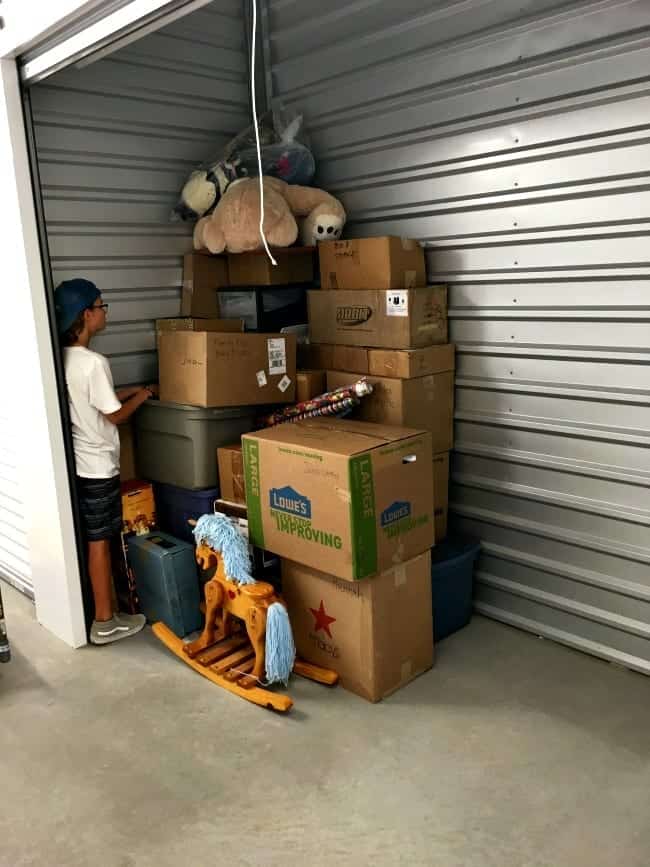
Do what works best for you
The best question to ask in this decluttering process is quite simple: What do you want to do? Not, what are other RVers doing? Not, what do your friends think you should do? Not, what will other full-time RVers think if we don’t sell everything?
What works best for YOU.
Do you want to sell everything and not mess with a storage unit? Great. Then do that!
Do you really like your household furnishings, have family heirlooms and the thought of letting go of those things kills you a little inside? If so, store them!
It’s up to you. There’s nothing wrong with either answer. Make it work for you.
Most likely you’ll have to declutter a little (or a lot)
Now, whether you’re selling everything or not, most likely you’ll have to declutter regardless. This step can be extremely emotional and just about send people over the edge.
Here’s what we recommend doing and what we did personally.
Start with the garage.
When just the idea of the task of decluttering started to overwhelm us and give us heart palpitations, we decided the easiest way to go about this was room by room. And the room that made the most sense was the room that held most of the items we didn’t use or see on a daily basis.
Our garage held all those boxes of items that went with us (often unopened) from move to move to move. So we started there. We went box by box and sorted everything by what we would keep, sell, bring with us or donate.
We continued to do this room by room until we were done. A few dozen trips to the donation store, the storage unit, and a few garage sales mixed in for good measure, and we had officially tackled the decluttering process.
So, just start with one room. That one room will lead to the next room and so on and so on. Next thing you know, you’re done and one step closer to full-time RV living.
Step 4: Shopping For & Purchasing An RV
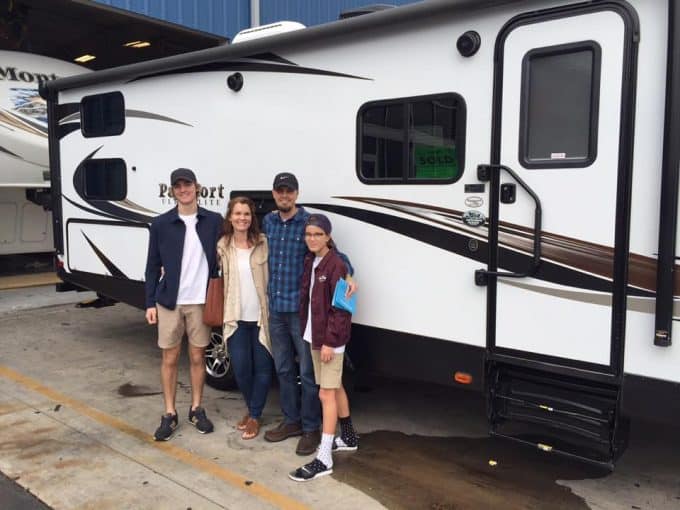
*If you want to see more of the financial details behind purchasing, and later selling, our RV and tow vehicle, check out this beefy post we put together recently. And if you are curious why I immediately spent $600 to add something to my brand new RV, take a look at this important post I wrote that could save you some serious heartache and money.*
Of all the steps we worked our way through during this process of transitioning to full-time RV living, this step was easily the most emotionally exhausting. (Physically exhausting comes in on the next step: Getting the House Ready to Sell.)
It’s not very hard to understand why this took such a toll on the emotions. Consider these tidbits:
- We had never owned an RV, or even really considered owning an RV, prior to this moment. Absolutely everything was new and overwhelming.
- I didn’t know what I didn’t know. I was terrified of not having all of the relevant information, not seeing the big picture, and of ultimately choosing the wrong RV option and regretting it.
- We were undertaking this major purchase without knowing how the rest of the pieces of this crazy puzzle would come together (selling the house, buying an adequate tow vehicle, etc.).
- We did not have any idea of what our exit strategy looked like when we were done with full-time RVing, whether we would even choose to keep the RV when our big journey was over. Whenever that would be.
I could point out plenty of other smaller details about this process that would help you understand exactly why I was emotionally exhausted. But these four points above account for the bulk of the exhaustion. I’m sure you can understand how this situation could wear on a fella.
A Few Key Pointers for Your RV Shopping Experience
And maybe you find yourself in a very similar position right now, bringing you to this post. If so, maybe I can give you a few pointers to help you take the next step forward with at least a little more confidence and a little less exhaustion.
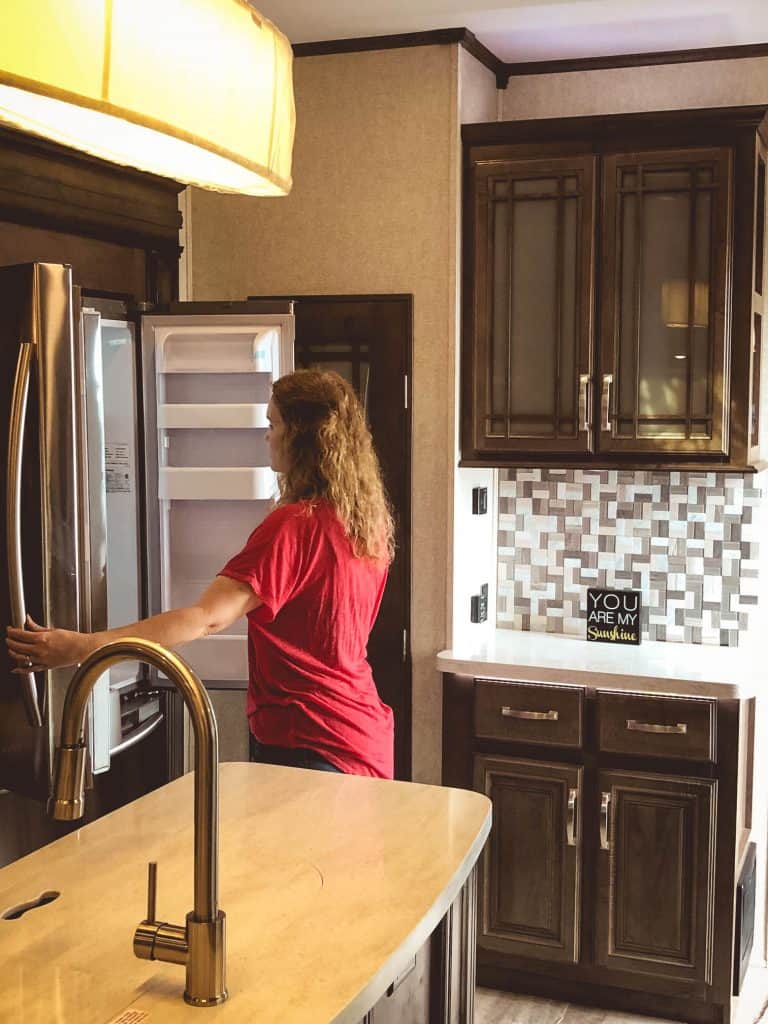
Challenges of Financing the Purchase of a “Luxury” Item
We went into this experience knowing that we would not be paying cash for our RV. Sure, we had some cash set aside, but it was in the “down payment” range, not in the “buy with cash” range. We discussed our situation early on with our RV salesperson and got some solid guidance that we want to pass on.
If you are going to be financing the purchase of an RV of some sort and then a vehicle to tow the RV, or to tow behind the RV, be sure to take care of the RV purchase first.
Regardless of whether you see your RV as a luxury item, the financial institution absolutely will. This means that it is a very different process from a standard vehicle purchase. Completely different lending guidelines, credit requirements, down payment requirements, etc.
Narrow Your Search Down ASAP to Either Towable or Driveable RVs
You’ve got to take baby steps through this process, folks. And the more logical and organized those steps can be, the better. So the first baby step is to decide what type of RV is going to make the most sense for your situation.
Obviously, this involves considering different facets of your situation: family size, finances, willingness to deal with smaller spaces, amount of debt you are willing to take on, etc. When we dealt with this baby step, we quickly realized that a towable RV was the only thing that made sense for our situation.
Towables, and especially travel trailers, have much lower purchase prices overall than anything in the towable category. And since this is a luxury purchase, we knew we needed to keep that price tag as low as possible to keep ourselves in a good situation financially.
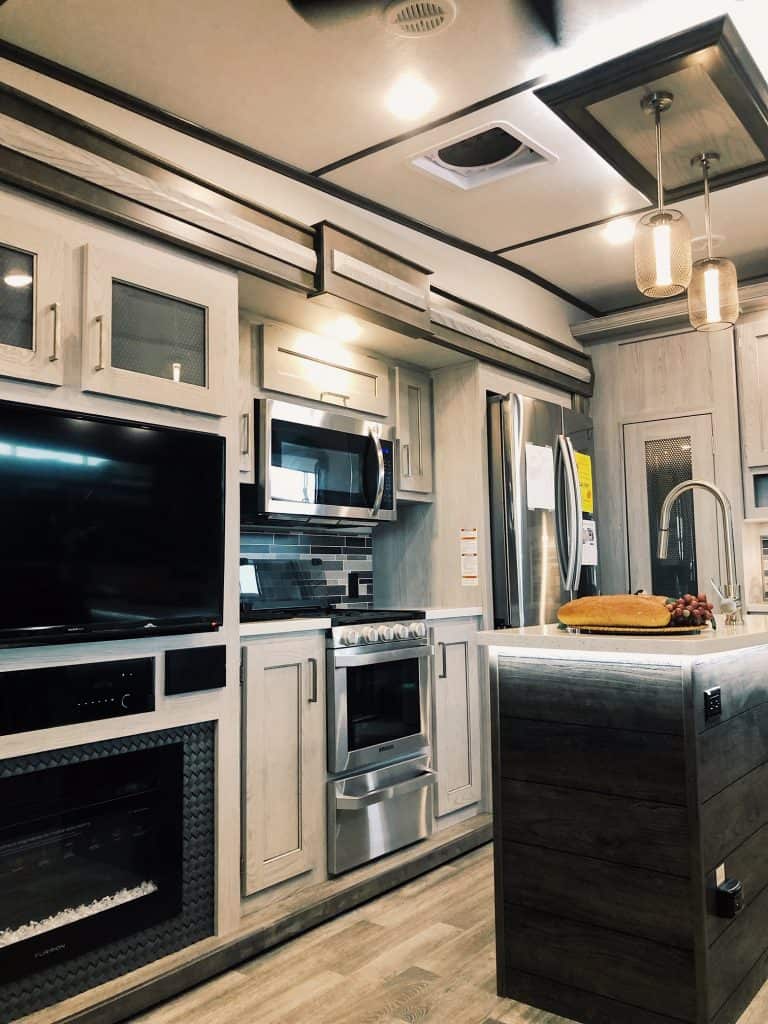
Decide Early On Which “Creature Comforts” Are Absolute Must-Haves and Which Ones Would Just Be Nice
When I talk about “creature comforts”, I’m also referring to the overall living space that you are willing to adapt to. In our situation, we were willing to sacrifice quite a bit in terms of both space and convenience in order to make this crazy dream a reality.
We ended up in a 26-foot travel trailer (less than 200 sq ft of living space) with one bathroom with five of us along for the ride for months at a time. Was it tight? Yup. Was it a challenge? You bet. Did it sometimes test our patience? Duh.
But was that sacrifice worth it for us in order to have some financial peace of mind and still have the experience of a lifetime? Absofrigginlutely.
Each person, each family, is different. Be honest with yourself and with your family about what you feel you must have to survive, but please don’t be afraid to push your comfort zones here. We definitely pushed ours with our smaller RV, and we don’t regret it one bit. If you aren’t ready to push your comfort zones, you may need to stop and consider why you are attracted to this lifestyle in the first place. Believe me, it’s all about invading those comfort zones!
But how could we possibly regret it after everything we saw, everything we experienced, all the family memories we made?
(You might be interested in my post about why you need less RV than you think. You might agree with it, you might not. But at least it will help you to keep thinking through all of the perspectives and angles you should consider as you work your way through this process.)
Step 5: Getting the House Ready to Sell
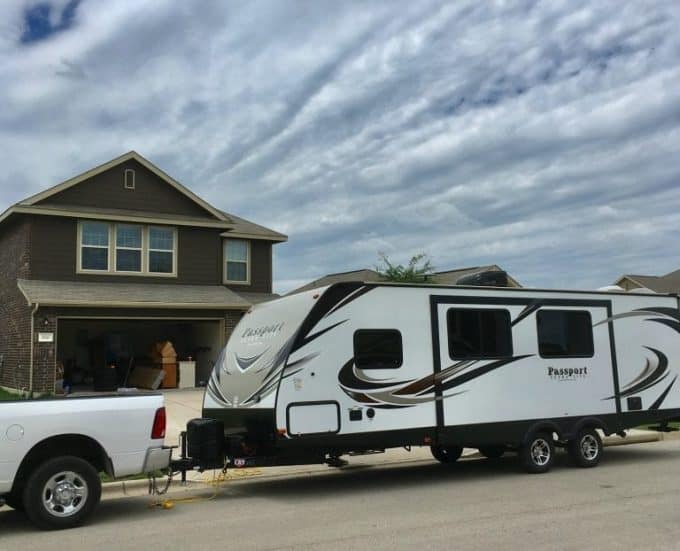
If Step 4 was the most emotionally exhausting, then Step 5 was absolutely the most physically exhausting. Oh. My. Gosh.
I’m not a guy who has done a ton of manual labor in my life. I do most of my heavy lifting with my brain…and my fingers on the keyboard. So you can imagine that taking on the heavy lifting of preparing our house for sale was quite a shock to the system (and to my back, as this post details).
Now, I want to point out that we had purchased our home brand new just 3 1/2 years earlier. So it’s not like I had any major renovations or upgrades to take care of here. And it’s a good thing since it all had to happen in 5-6 weeks! No, this was primarily about two main tasks:
- Processing through all of the stuff we had accumulated and needed to get rid of (or move to a storage space)
- General sprucing up, painting, deep cleaning, replacing some carpet, etc.
Sure, when I put it into two simple bullet points like that, it doesn’t look like much. But did you know that a family of five can accumulate a bunch of (heavy) stuff in 20+ years? I know, shocking. They can also create a remarkable amount of “grunge” together, even in a brand new home.
So I did have my work cut out for me, and while my wife did the lion’s share of the income creation work with her established blog during this period, my 12-year old son and I really took the lead on getting our home ready to sell. (He was homeschooled at this point, so he had some flexibility that allowed him to pitch in big time. And boy did it help!)
My Biggest Piece of Advice For This Step: Start NOW
Here’s the deal: We had made quite a few moves in the 15 years prior to this point. With every move, we had always felt that we were “ruthless” in getting rid of unnecessary clutter. So we kind of prided ourselves on not being “pack rats”, on not hanging on to stuff just because.
It was quite any eye-opening experience, then, to really get down the nitty-gritty of processing through our piles o’ crap. It seemed that our possessions had almost doubled in the nearly four years we had lived in this home! Remarkable, and daunting.
So what’s my biggest piece of advice for you? Start dealing with your piles o’ crap today, not tomorrow!
You have more stuff than you think. You are more connected to it than you would like to admit. Letting go of it will be both emotionally and physically exhausting. So give yourself as much time as possible to work through that process and not feel rushed on top of everything else.
Use These 3 Important Questions to Filter Your Possessions

If you choose to face down your mountain of possessions without any tools to help you filter them, to decide what goes and what stays, you will be disappointed. And very, very frustrated.
You need a framework to operate with here, to pull you forward through this daunting process, or you might give up before you really get started. So here are three questions to use, that act as filters for your stuff, to determine what you keep and what you give up:
- Have I touched this item in the last six months?
- Can I replace this item for less than $20 and within 20 minutes of my home (or through a quick online order)?
- Does this item bring joy into my life?
These questions will be very helpful for you whether you are preparing to RV full-time or not. They will help you see things more clearly and make hard decisions not quite so hard. They will reduce the “decision fatigue” that inevitably comes with this process and breathe new life back into this critical step.
Understand that these questions are really just a starting point when you are talking about transitioning to life in an RV. Because there is one more primary question that you can’t skip before a decision is made: Will it fit in my RV?
If you are still on the fence about full-time RV living as you read through this info, you should take a look at my post that deals with the question, “Is full-time RV living right for YOU?” In that post, there are links to my 39-page ebook. It helps you honestly tackle this giant question and find the answer that is only right for YOU. And that’s all that matters, right?
Step 6: Finances – Remote Income & Cutting Costs on the Road
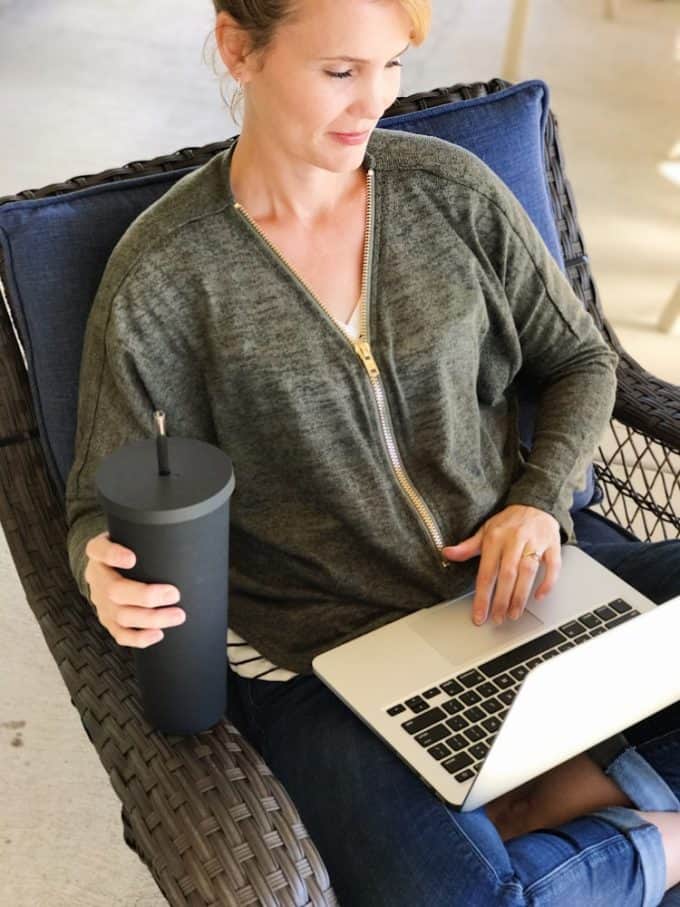
Ah, money. Always enjoyable to talk about, especially when it’s coupled with words like “household budget”. Ewww. I know.
But let me tell you why I think this is such an important step to cover: Because for us, full-time RV living ended up costing us more than we had planned for or expected. Luckily, we had enough cash reserves to make it work, and we had created remote income streams that kept us going, but that doesn’t mean it wasn’t a bit stressful at times. More stressful than it could have been, for sure.
If I had to guess, I would say that “additional stress” is not one of the factors that is pulling you toward full-time RV living. No, you are hoping for just the opposite. You want to escape the grind, slow down, relax a little, adventure a lot and stress less! And if that’s the case, you have to deal with this financial thing ahead of time…or pay the price.
Do You Need to Create Remote Income?
If you don’t find yourself in the retirement stage of life right now, and you want to do this crazy full-time RVing thing while you are still “feeling young”, then creating some remote income might be at the top of your ‘to do’ list right now. And in case you hadn’t figured it out yet, there are thousands of possibilities for making money remotely. It can be utterly overwhelming.
The key thing to understand, however, is that not all of those possibilities are going to be a great fit for YOU. For instance, if writing does not come naturally to you and you haven’t built up those muscles in your current work or on the side, starting a blog is probably not your best move. This effort requires writing thousands of words per week to really get the ball rolling, on top of all of the marketing and promoting, and some knowledge of the technical aspect to keep it running. All of that is easier said than done.
But maybe you have a background in retail or in marketing and the idea of starting something in the eCommerce realm feels like a far better fit. Well, even there you have so many options for how you will set up that online income creation effort.
The possibilities and opportunities are literally endless in almost any niche of remote income creation that you begin to explore.
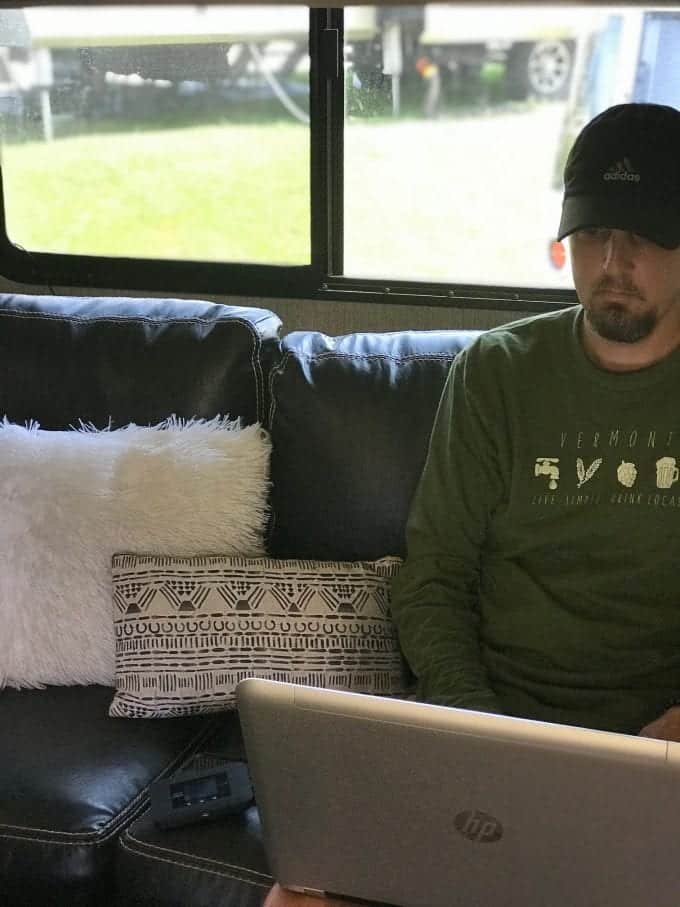
Follow the Ones Who Have Done It Already – Remote Work 101 Online Course
We have been operating in the world of online income creation for a very long time. Believe it or not, we started our first eCommerce site in 2002. (Spoiler alert: It made about $150 total.)
So when we say that we have tried it all…well, it’s not too far from the truth given more than 17 years of trial and (much) error. I’d say we’ve tried too many different things, as a matter of fact, and not done so great at the “consistent and persistent” side of the online income equation. Still learning that lesson, no doubt.
But the bottom line is that we have learned one very important lesson from all of that experimenting: Find someone you trust who has already been where you want to go and become an expert! Then follow their system and guidance precisely instead of tweaking to fit you from the very beginning.
Enter Camille Attel and her Remote Work 101 Online Course. She also has a helpful blog called More Than A Wheelin’ with tons of free information about finding remote work and creating income. It’s a good place to start.
My wife, Julie, met Camille at a blogging conference. Camille and her husband are full-time RVers who have been exactly where you are, trying to figure out how to make this life on the road work long-term. They took months then years learning how to make a remote work-life balance and affordable.
Income is Good…But What About Saving Money on the Road?
Yes, more money helps. But only if you can find ways to also save some money, to keep that income from just flying out the back door!
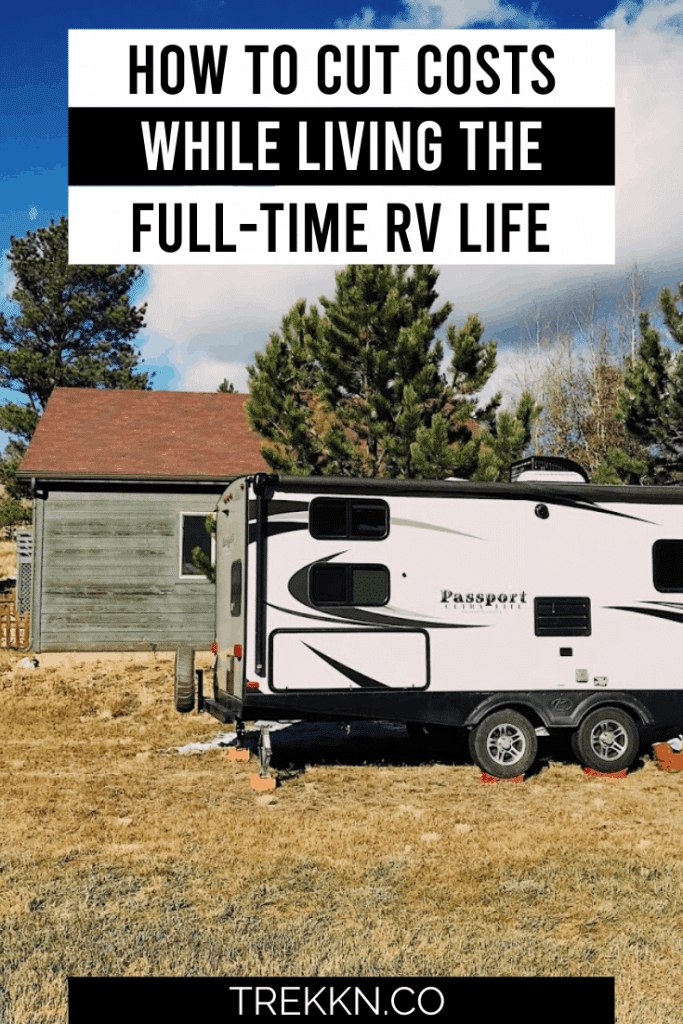
Instead of going into a great deal of detail here, I am going to simply point you to a lengthy post I wrote that covers Five Ways to Cut Costs While Full-Time RVing. But I will give you the quick rundown of what I cover in that post, so you know if it might be of value to you at this point:
- FIND THE RIGHT RV PARK AND CAMPGROUND MEMBERSHIPS
- TAKE ADVANTAGE OF ANY FUEL SAVINGS YOU POSSIBLY CAN
- TAKE MEASURES TO AVOID A TIRE BLOWOUT DISASTER
- SLOW YOUR ROLL, PEEPS! (TRAVELING AT A SLOWER PACE)
- EQUIP YOUR RIG FOR MAJOR BOONDOCKING OPPORTUNITIES
Between increasing your remote income and decreasing your overall costs while traveling, you will maximize your enjoyment and reduce your financial stress as much as possible. To me, that is the perfect combination when you are looking to re-invent your life and go against the flow.
Really take some time to dig into everything covered in our cost-cutting post. As much as we might want to deny it, the financial side of things will have a major impact on your full-time RVing experience. I want the absolute best experience possible for you, so dive in and make some amazing things happen!
Step 7: Shopping For & Purchasing A Tow Vehicle
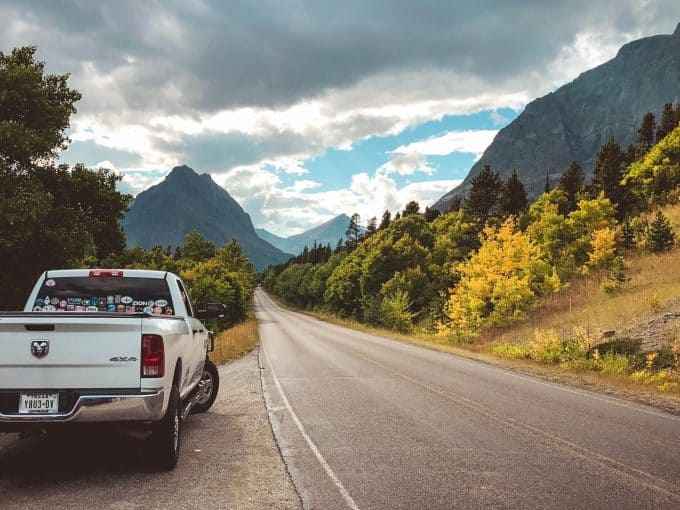
*If you want to see more of the financial details behind purchasing, and later selling, our RV and tow vehicle, check out this beefy post we put together recently.*
You might think that after surviving the RV purchasing process, the task of purchasing a regular old tow vehicle for that RV (26-foot travel trailer) would be far quicker and easier in comparison.
In my case at least, you would be wrong. Very, very wrong.
Because here’s a big shocker: I had never owned a truck before either!! Not even a friggin’ SUV, for crying out loud. I had always been much more on the practical side, the “sedan and minivan” type of dude.
That’s right, I was just as clueless in this arena as I was with the RVs. Yay me! So the pile of questions I had to work through and answer felt monumental and disorienting once again:
- Are there any half-ton trucks that can safely tow 7,000 pounds around the continent? Or is a 3/4 ton truck the only option?
- Do I listen to these people in the forums telling me to go with a 1-ton truck “just in case” I want to upgrade my RV to a larger model later?
- Is a diesel truck the smartest way to go? Or is that just overkill for 7,000 pounds?
- If I go with a Ford diesel, which engines do I need to completely avoid because of major problems historically?
- Or should I spend the money to “bulletproof” an older Ford diesel engine?
- Can I even find a diesel truck close to my price range that I can feel confident in?
- If I buy a gas truck, will I get eaten alive when I trade or sell due to more rapid depreciation than diesels?
- What is the minimum axle ratio I need to be safe?
- How can I be sure I won’t exceed the truck’s GVWR (Gross Vehicle Weight Rating) with the travel trailer’s loaded pin weight?
Without my truck-owning friends (thanks Jay and Bob!), YouTube and some RVer online forums, I would never have navigated all of these acronyms and new terminology and survived this period. For nearly eight weeks, as we prepared the house to sell, negotiated with potential buyers and waited for the closing, I nearly researched and shopped myself to death.
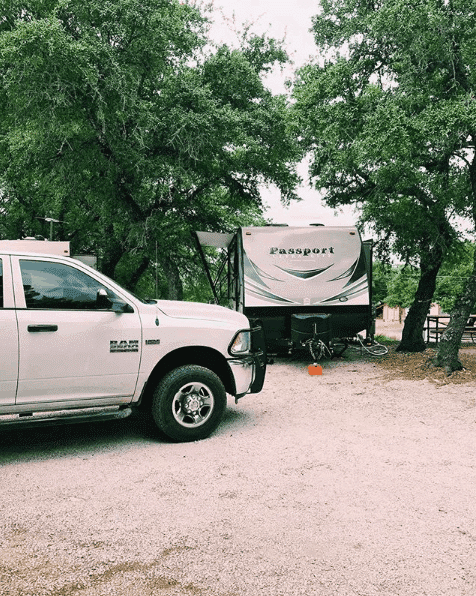
New Truck? Not An Option.
I figured out pretty quickly that buying a new truck was not an option at today’s eye-popping prices. I would have been very lucky to stay under $45K for a properly equipped new rig, and that was simply too rich for my practical blood.
So not only did I need to figure out and understand the specs for the truck, I had to try and make sure that I wasn’t getting “hung out to dry” with a lemon of a used truck! The pressure of this decision sometimes felt like it was just too much to bear with the safety of my family and the hopes for a smooth journey hanging in the balance. But, we pressed on.
Pulling the Trigger and Praying
Once the house had finally closed in early May 2017 and we had the proceeds from the sale, the moment of truth arrived. After all of my stressing and shopping, I ended up finding (what I believed was) the right truck just about two miles from our home: A 2013 RAM 2500 Tradesman 4×4 Long Bed with 5.7L Hemi engine.
She had a bit under 36,000 miles on her, enough room to accommodate all five of us in the family (though not in absolute comfort and style), and came in just under $27,000 (plus the extended warranty I purchased). I felt quite pleased with this truck and was SO ready to get out there and actually tow my RV that had been sitting in the storage lot for two months! I only had about three weeks to get the hang of it before we hit the road.
And how did Benny the Truck end up performing for us on our long journey? Absolutely beautifully! While towing my home 35,000+ miles, Benny required one $700 engine repair (not covered by the warranty I purchased…dang), a new windshield and some new tires. Basically, I could not have been more pleased with his performance. (And yes, I miss him a bit…just not his obvious lack of fuel efficiency.)
What Will Your Truck Purchasing Experience Look Like?
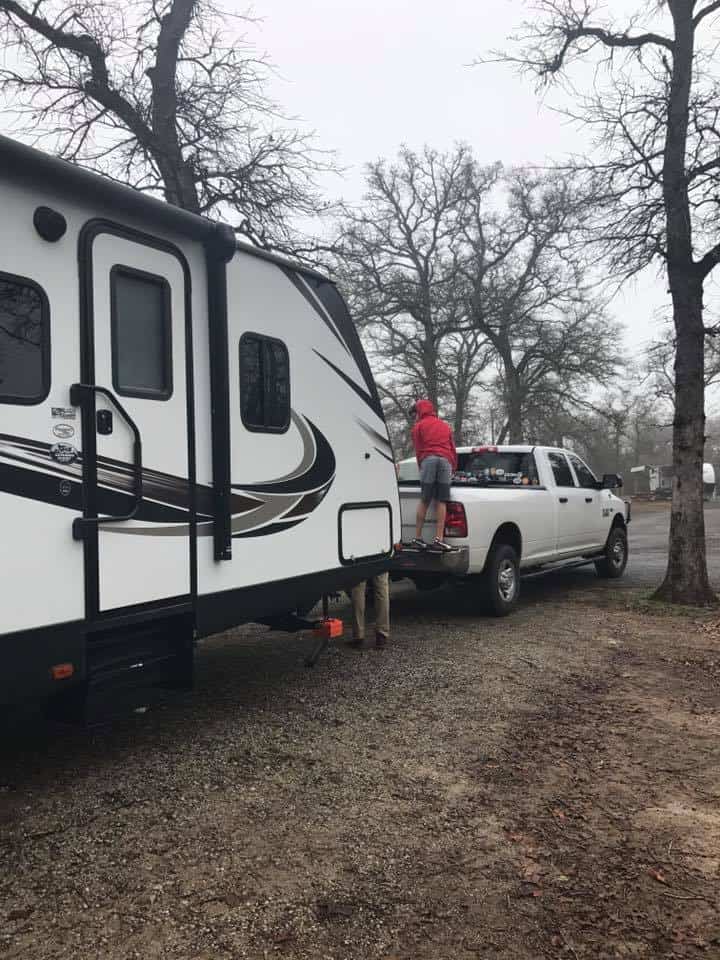
I’ve laid all of these details of our experience out there to try and help you understand that this is a very important decision. You should take your time to make the best one you possibly can. That will require some time and some “brain damage”, especially if you are new to the world of trucks and towing like I was.
But at the end of the day, you will still have questions and uncertainties about your decision. You will never be guaranteed to avoid problems, so you just have to choose to dive in, hope for the absolute best and trust that you can weather any storm that may come on this front.
*And if you are buying used, I personally recommend eating the extra cost of that extended warranty now instead of the potentially staggering cost of a new engine or transmission during your travels. Even though our warranty didn’t end up saving me a dime, it gave me priceless peace of mind for about $30 per month.*
Step 8: Buying ALL THE THINGS for That New Home on Wheels
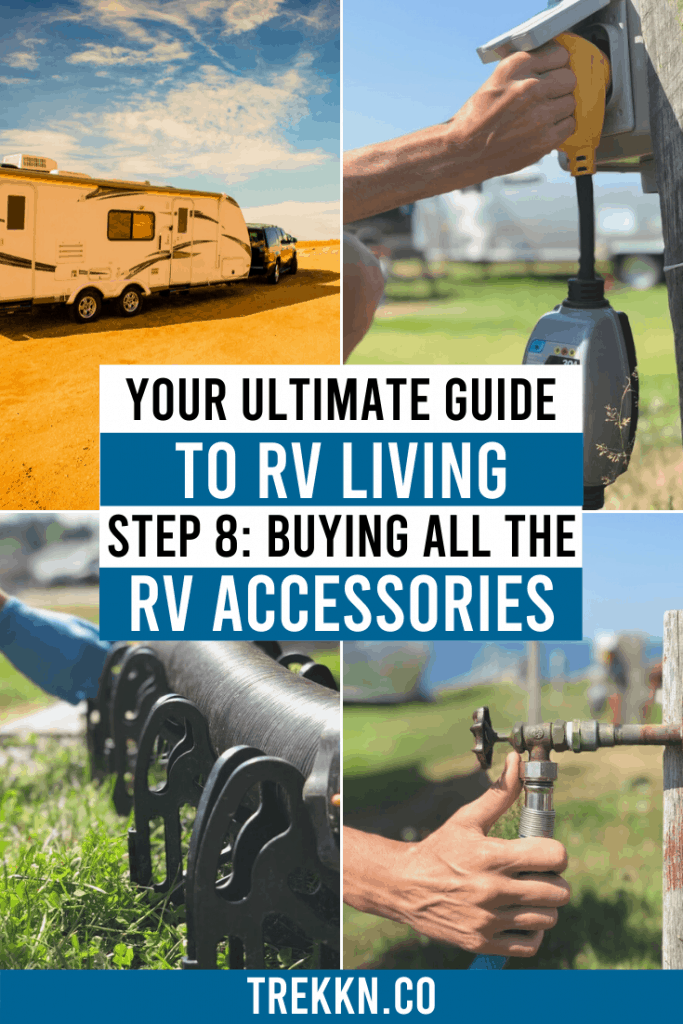
This step can be kind of easy to overlook initially with all the craziness of the first 7 steps. I mean, you’ve done the “hard stuff”, right? You’ve purchased your RV and your tow vehicle (if necessary). You’ve gone through all of that research, made all of those difficult decisions and spent all that money to get to this point. You’d probably love it if you could just hit the road NOW.
But that would be a mistake that you would quickly regret. As I covered in this comprehensive RV accessories post, your RV is still very incomplete and needs a host of supporting characters to make this RV living film into a real blockbuster.
Start With Essential Accessories: Sewer, Water, Electric
You wouldn’t move into a new home if you didn’t feel confident that you could flush the toilet, turn on the lights or get a glass of water from the tap, would you? Nope, me neither. These are the non-negotiables of modern living for most of us, and that’s no different in an RV.
Ensuring that you are equipped to properly connect your RV’s utilities to a fairly wide range of configurations at campgrounds and RV parks is an absolute must. Consider these possible scenarios, all of which we encountered in our travels:
- You find yourself at a “sketchy-at-best” RV park that causes you some concern. If you don’t have an electrical surge protector and circuit analyzer, plugging into their questionable electrical system is just a roll of the dice that could cost you thousands $$$.
- You have a 30-amp RV, but the RV park you want to book at only has a 50-amp site available. You are going to need a 50-amp Male to 30-amp Female Dogbone Adapter.
- You want to stay in your 30-amp rig “rent free” for a few nights at your in-laws’ home. You probably won’t make that happen without a 15-amp Male to 30-amp Female Dogbone Adapter.
- The RV park you arrive at has the sewer connection on the opposite side of the rig from yours. If you don’t have at least 20 feet of sewer hose, you’re out of luck.
- That water connection you need ends up being 30+ feet from your rig’s connection point. If you don’t have two quality 25-foot drinking water hoses, it’s going to be a very frustrating stay.
- Excited about exploring some colder climates in your RV? Prepare yourself with a heated hose like I purchased or the “winter hassles” will just keep on coming.
You get the idea here. The number of scenarios you are likely to encounter in your travels require some planning ahead of time to reduce your stress and your overall costs.
Take a look at my Must-Have RV Accessories post to get yourself ready to roll. You will be SO glad you did, trust me.
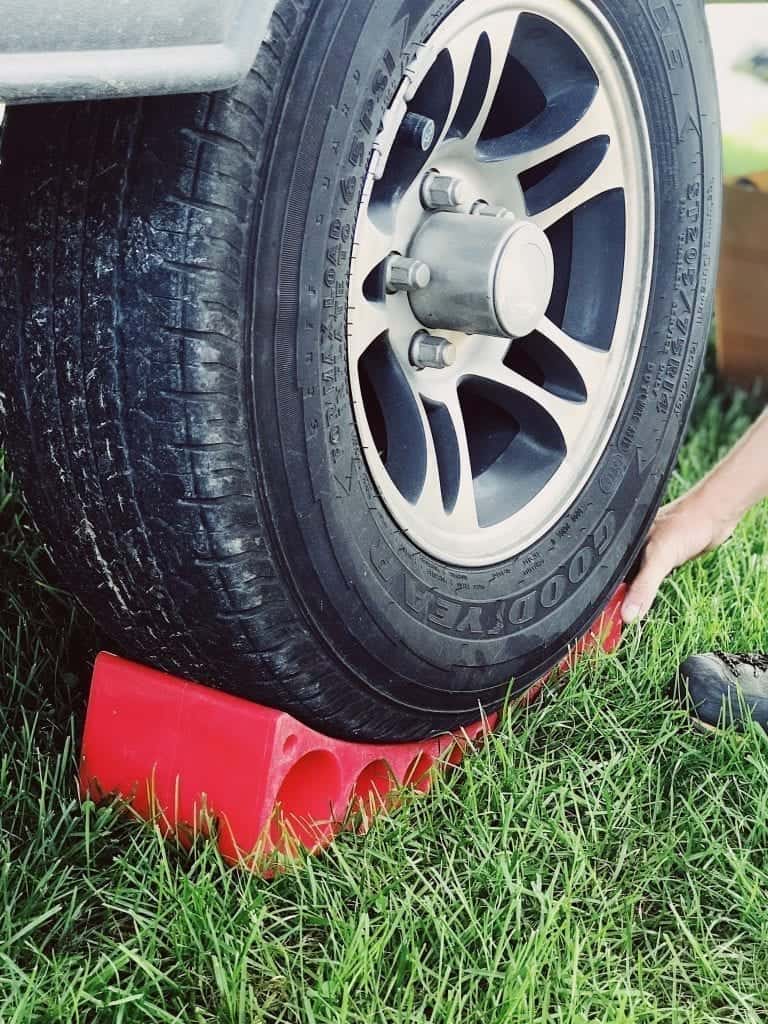
Safety Before Convenience
What’s the first thing you want to do after buying a brand new travel trailer? Well, you want to spend $600 on brand new tires to replace the brand new tires already on there, right?
No. Not if you are sane, at least. But that’s exactly what I chose to do immediately after purchasing my travel trailer. Why? Because I was determined for my family and I to have the safest full-time RVing experience we possibly could, and those tires were exactly where that effort had to start. (Read that full post about my brand new tires to get the full picture behind my decision.)
Listen, when it comes to RV accessories, safety has to come before convenience. For me, that effort started with the new tires.
But almost immediately after purchasing the new tires, I also made the difficult decision to invest more money in a quality Tire Pressure Monitoring System. I know, I know, they are expensive. I can’t argue with that. But when you consider that it is helping you protect those brand new tires, your RV itself and the quality of your overall RVing experience, it just makes sense.
I made these decisions because I made safety my top priority during our travels. Believe me, after traveling 40,000+ miles without a single tire issue, I have absolutely no regrets!
Take a minute to read my post about the five reasons you should purchase a TPMS today and then follow it up with a look at several other safety items I strongly recommend for your RV travels.
Get Hitched!
Maybe this goes without saying, but you should absolutely, positively not even think about hitting the road full-time in a travel trailer without purchasing a quality weight distribution hitch. These hitches, which normally include sway control components as well, ensure that the weight of your setup (truck and travel trailer) is more evenly distributed throughout.
The combination of an evenly distributed load and sway control are essential to providing you with a safe and comfortable towing experience. And when you are going to be towing for thousands and thousands of miles, that is absolutely a no-brainer! We chose a 4-point Sway Control Hitch. It was a game changer and I would absolutely choose it again.
As a side note, I actually located a very gently used Equal-i-zer hitch on Craigslist that I was able to purchase for less than half of the cost of a new one. I then had it professionally installed, which I would also recommend even though it wasn’t cheap!
When you choose to put safety first on the road, it allows you to enjoy every single aspect of your adventure…instead of being sidelined by a major incident. Think about it, and make the right decision for you.
Step 9: Moving Into Your Home on Wheels
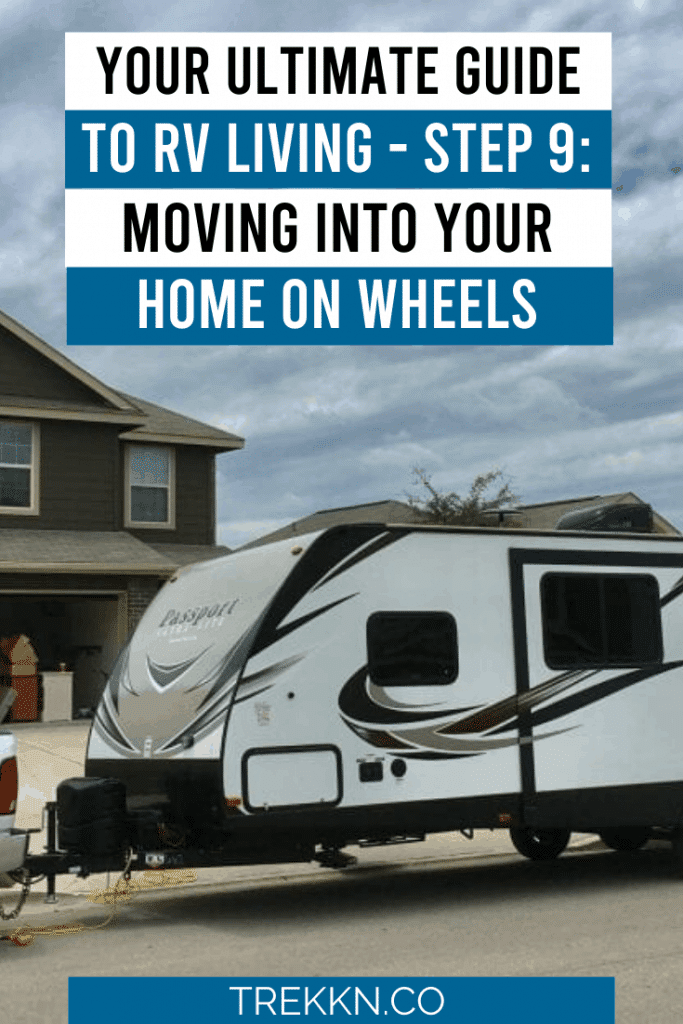
Moving. Isn’t it just grand? Doesn’t that word just make you feel all warm and fuzzy inside? Yeah, right.
I know better than most the ‘joys’ of moving since I have easily lived in more than 30 locations in my adult life. No, I don’t even know how that is possible.
But here’s the really good news: Since you have already worked through the “Decluttering” step, you’ve already done most of the work actually required to make the RV move-in process go off without a hitch! (No pun intended…and you do need a hitch. See section above.)
Now, that’s not to say that you will know for sure that everything you have kept aside (not stored, sold or donated) is actually going to fit into your RV. You might have some surprises at this stage and realize that you were a bit overly optimistic about how much you could fit into this limited space.
Take a deep breath and roll with it, make the adjustments necessary, and I can almost guarantee you that you won’t miss whatever it is you have to leave behind. You’d be absolutely amazed what you can easily learn to do without! And almost anything you choose to leave behind can be easily replaced, if necessary, during your travels.
Guesswork Won’t Cut It When It Comes to a Safe Load on the Road
We can’t talk about moving into your RV without covering some of the basics of how to load your RV properly to ensure that you stay in control on the road. These tips we will cover apply most specifically to towable RVs, and we will obviously convey the lessons we learned as travel trailer owners. So be sure to take some time to research safe loading practices for whatever type of RV you find yourself in for your adventures.
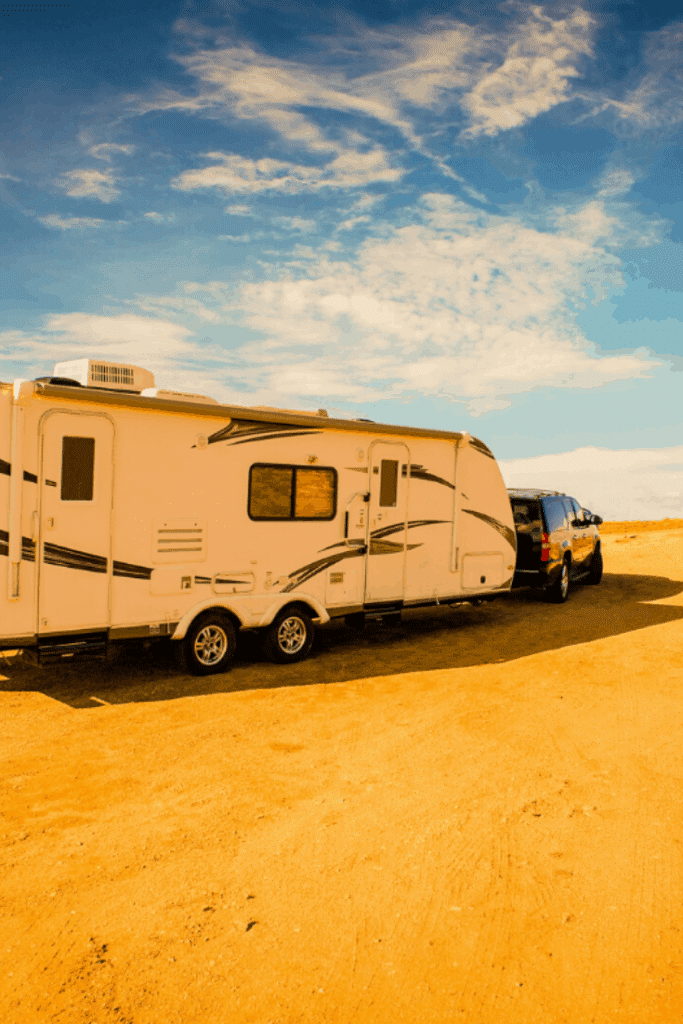
When it comes to loading a towable RV for travel, proper weight distribution is key. And no, that weight distribution hitch is not going to do all of the work for you here. There are a couple pieces of advice you should heed during the loading process, and throughout your travels, that will help to keep you safely moving down the highway:
- The heaviest portion of your load should be as close to the axle as possible, or slightly toward the front of your towable RV. But overall, you should shoot for 60% of weight in front of the axle and maximum 40% behind the axle. If you end up with too much weight at the back, you will sacrifice a dangerous amount of control, as this video clearly demonstrates for you. (And their Weigh Safe product deserves some serious consideration as well.) Here is a full explanation taken from the video description:
“Proper trailer tongue weight improves the vehicle and trailer towing experience by improving performance. Not enough tongue weight or force on the hitch/tow ball causes an increase in trailer sway from side to side, making it difficult to control. Conversely, too much tongue weight or force on the hitch/tow ball could overload the rear tires of the towing vehicle, pushing the rear end of the vehicle around. This could also negatively affect the vehicle handling. Performance is impaired as you might not be able to go around corners and curves properly, and your vehicle may not stop quickly enough when you press the brake pedal.”
- Even though it might be a bit of a hassle, spending the time and money to regularly weigh your setup on a certified scale (normally found at larger truck stops) will help ensure that you have not overloaded your RV setup or improperly distributed the weight. “Weight creep”, the tendency to slowly add more weight to your RV, is real! Make sure you monitor your weight regularly to avoid a disaster which can easily be caused by overloading.
- Paying attention to how your load is balanced out from side to side is also very important. If your RV is leaning to one side or the other because of improper loading, it will also cause a decrease in stability and handling. Check the tilt of your RV before taking off each travel day, because this shift can also happen slowly and can be hard to notice.
Step 10: RV Practice Run
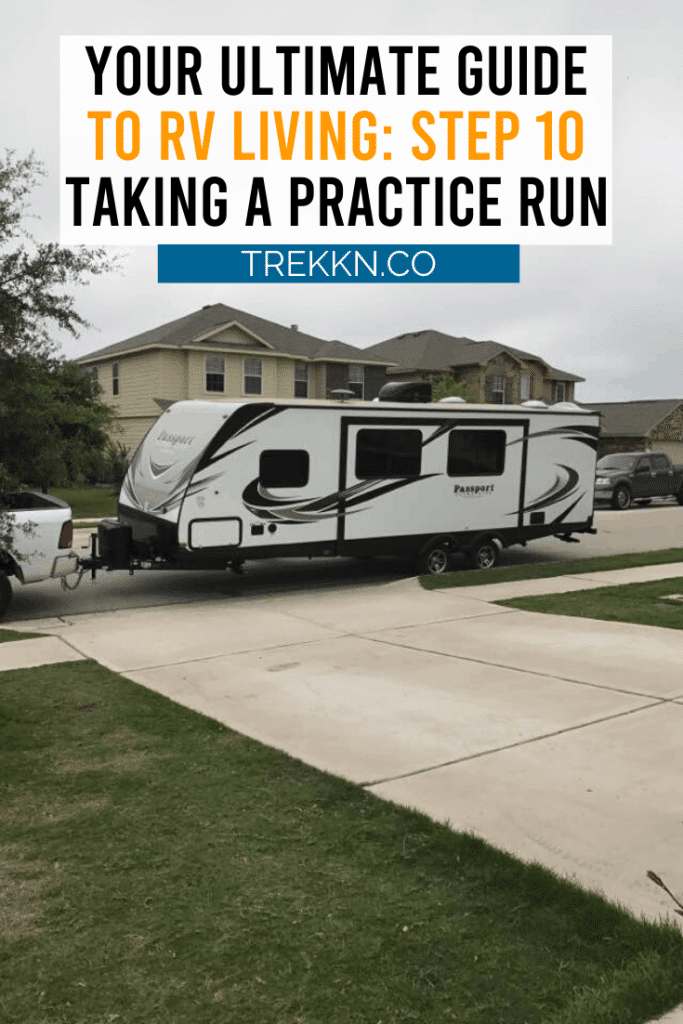
I’m not going to lie to you here: Making the decision to stay close to home for a few weeks and get your feet wet as a new RVer can be a big challenge. (If you aren’t an RV newbie, you’ll have to decide whether a practice run as a full-timer makes sense for you.)
Just think about it: You’ve spent months and months decluttering, communicating with friends and family, downsizing, selling a house (possibly), buying an RV and tow vehicle. The stage has been set, you are ready to roll…and you still have to stay within a couple hours of your home and support network?
Ugh. I mean, you just want to get out there and see the world, right? You just can’t wait a minute longer! Or can you?
It’s Still An Adventure…Just A Limited One
I get it, really. Honestly, I’m not sure that we would have really done a proper “practice run” for several weeks if we didn’t have the built-in need to stick around for a family wedding in our hometown. It worked out perfectly, as a matter of fact. We stayed within about two hours of our friends and family in the Austin area for the first month and then really hit the road and headed north into Colorado after the wedding.
During that month, we had plenty of excitement and adventure at three or four different campgrounds; it was just of a bit warmer variety than we would have preferred. We were aching for that “mountain chill” up in Colorado and beyond, but it honestly just made it all that much more satisfying when we finally did escape the heat up in those higher elevations.
And if something had gone terribly wrong in those first weeks? If I had damaged my RV while backing it in somewhere? (Probably my greatest fear, and I came far too close to it once.) We had friends, family, and the dealership we purchased the RV from just a short drive away to manage the entire (unfortunate) situation.
Essentially, as brand new RVers it offered us some much-needed peace of mind as we launched into this completely new world and got ourselves acclimated to its unique rhythm, requirements and rules.
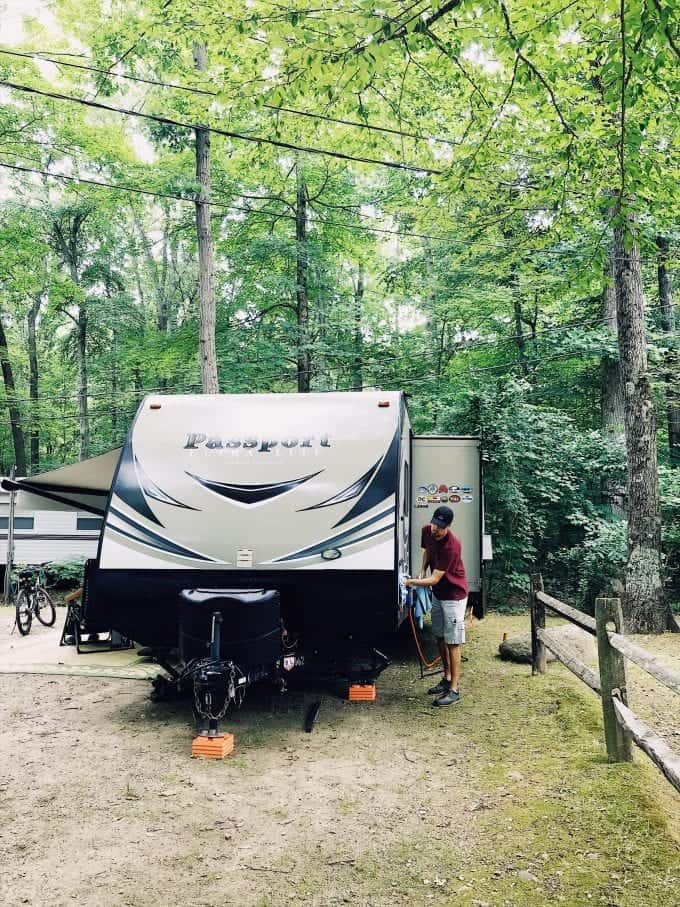
Let’s Decompress, Shall We?
And for me personally, it was a period to decompress, to recalibrate after the constant pressure of preparation that I had carried for the last few months. That was a welcome relief! (Side note: This was also a period to recover physically for me after my back completely gave out on me right as we moved into the RV. That was a real joy, let me tell you.)
My advice? Limit your travels for that first month of RVing so that you will allow yourself the best start possible to your RVing adventure. There’s plenty of time to see everything you want to see; it’s not going anywhere. So make the smartest choice and plan your practice run as you head out. (Hint: It will probably give your loved ones, the ones who think you’ve lost your mind, a little extra peace of mind as well. It’s a nice parting gift to give them!)
Step 11: Saying Goodbye and Officially Launching Into Full-Time RV Living!
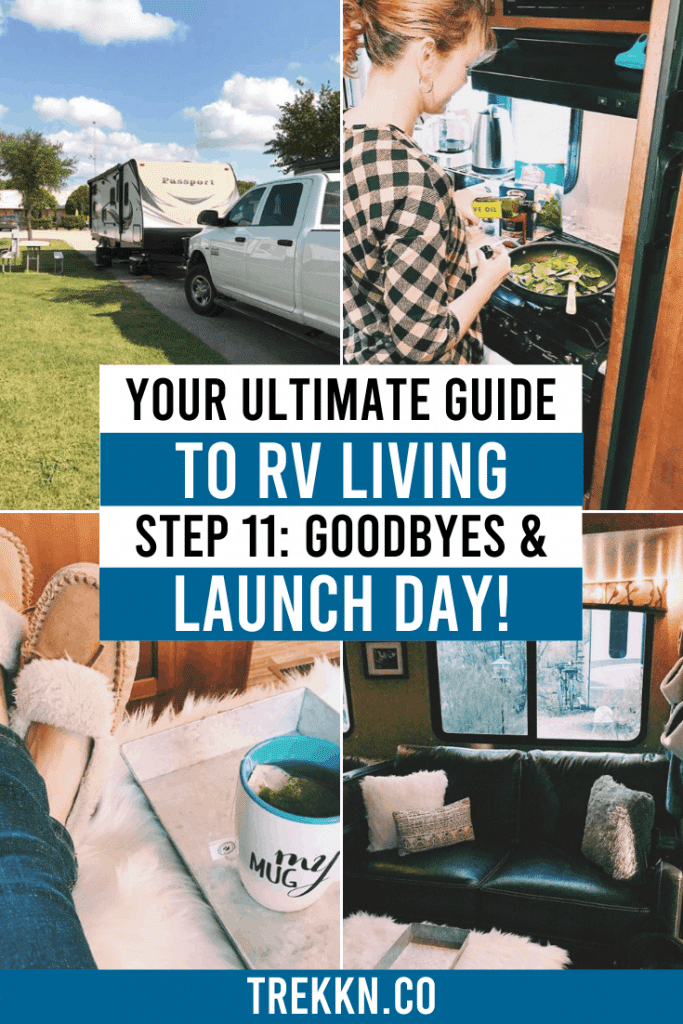
Can you believe it?! After all those steps and all those words to help prepare you for this huge step, it’s actually time to LAUNCH! I’m not sure the astronauts feel much more excitement than a full-time RVer on launch day. At least that was definitely our experience.
So many butterflies, so many hopes and dreams, so many bucket list items dancing around in your head! Oh, and still some remaining questions and fears (you can read about our biggest fears before hitting the road right here). No, they do not all completely evaporate during your practice run, but they definitely become more manageable before you hit the open road. There is absolutely no doubt about that.
Step Back and Appreciate What You Have Already Done
But before you hit the open road, take an evening to sit around the fire with your loved ones and relive some of the highlights of this amazing process you have already gone through to get to this point. Talk about the moments where you really thought this was never going to happen, talk about the possessions that you didn’t think you could part with, remember the fears that you had to overcome, the doubts that plagued you, the obstacles that stood in your way, the people that disagreed with this decision.
Just take a few minutes to appreciate the fact that you are here, you have grown during this process and you will never be the same even if you don’t check a single item off of your bucket list.
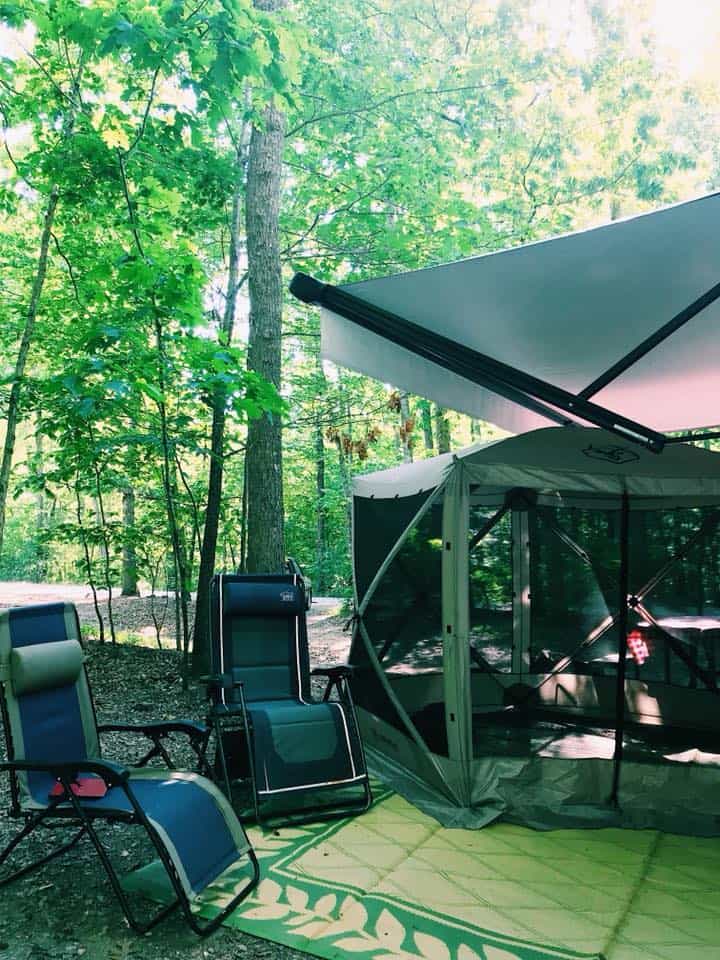
You have made a choice that felt right for you, even though it was terrifying and tough and maybe unpopular. That’s important, and for you it may just be a major turning point in your life that will change the entire course of your life from this point forward. Not because you are living in an RV, but because you chose boldness, you chose the unknown, you chose uncertainty over “safety”. You chose to take a risk and LIVE.
And that, my friend, that has a way of shaping you in ways you probably can’t quite grasp right now.
Make Plans to Stay In Touch With the Ones You Love
If you have close friends and family that you will be leaving behind during your travels, folks that you really want to be sure you stay in touch with and share your experiences on the road, consider committing to a scheduled check-in with them.
Whether it’s by phone, video chat, or other means, putting something on your schedule will help ensure that you don’t inadvertently neglect the relationships that matter the most to you in the midst of the excitement (and possibly occasional stress or struggle) of life on the road is your best bet. The days have a way of blending together out there, so anything you can schedule would be a wise move.
A Few ‘See Ya Laters’
Now, it’s time to hug some necks and probably shed a few tears as you say goodbye to those closest to you. It will absolutely be a mixture of emotions, and it might get a little messy, but I’m betting that it won’t slow you down too much.
Because you’ve got this, you’re ready, and the entire continent really is your oyster now as you set off on the adventure of a lifetime!
Just remind them (and yourself) that this isn’t a forever thing. This is an adventure thing that will allow you to return home if needed, and when the time comes.
Let the Good Times ROLL!
We wish you nothing but the safest and most fulfilling adventures during your RV travels. And we are confident that on the other side of all of this, whenever that may be for you, you will look back with pride and extreme gratitude on all that you have accomplished, all that you have experienced, all that you have learned about yourself.
Because this opportunity is a gift. Don’t ever forget that.
Feeling More Prepared to Dive Into Full-Time RV Living?
I’ve gone to great lengths here, and honestly, on every other post, I have written on this site, to use our real-world experiences with full-time RVing to add value and perspective that will serve you well. I truly hope you have found that this Ultimate Guide to RV Living, has helped you move forward smartly in your preparation for the RV lifestyle.

Julie specializes in helping you whip up delicious meals in your tiny RV kitchen, as well as RV organization tips and helping fellow RVers make their RV feel like home. Her favorite RVing spot is in Banff National Park in Canada where yes, the water really is that blue and the people really are that nice.



